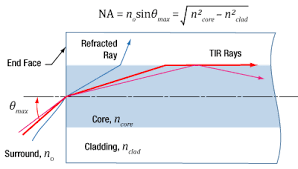Contents
Introduction
Optical fibers, the backbone of modern communication systems, rely on intricate principles for efficient light transmission. One crucial parameter that significantly influences their performance is the acceptance angle. In this blog post, we will delve into the intricacies of the acceptance angle, understanding its definition, calculation, and its implications in the realm of optical fibers.
Acceptance Angle and Numerical Aperture
Defining the Acceptance Angle
The acceptance angle of an optical fiber, rooted in ray optics, is the maximum angle at which an incident light ray can hit the fiber core against the fiber axis and still be guided by the core. This phenomenon is facilitated by total internal reflection at the core–cladding interface.
Numerical Aperture: A Key Parameter

Visualizing the Concept

Figure 1 provides a visual representation, illustrating total internal reflection within the acceptance angle and the consequences for incident light beyond this angle.
Calculating Acceptance Angle: A Step-by-Step Guide
To better understand the practical application of the acceptance angle, let’s consider a step-by-step calculation using specific values:
Input Values:
- Core index: 1.46
- Cladding index: 1.45
- Index of input medium: 1
- Numerical aperture: 0.171
Calculation:
Acceptance angle=arcsin(0.171)
Acceptance angle≈9.82∘
This calculated acceptance angle is instrumental in estimating the maximum input angle of a laser beam for optimal launch efficiency in strongly multimode waveguides.
Considerations for Single-Mode Fibers
Deviating from Geometric Optics
While the acceptance angle concept is foundational in the context of multimode fibers, its relevance diminishes for single-mode fibers. In these cases, wave aspects become paramount, especially in fibers with small cores.
Realities of Light Beams
Real light beams, such as laser beams, deviate from the idealized ray model. They possess finite beam radius and divergence, challenging the notion of a well-defined transition between guidance and non-guidance as the beam angle varies.
Applicability in Large-Core Multimode Fibers
Geometric optics, approximated by the acceptance angle, finds greater accuracy in large-core multimode fibers. However, for highly multimode waveguides, gradual variations in launch efficiency should be considered.
Conclusion
In conclusion, understanding the acceptance angle in optical fibers is paramount for optimizing the efficiency of light transmission. While deeply rooted in geometric optics, it’s crucial to acknowledge its limitations, particularly in the context of single-mode fibers and the wave aspects of light. The acceptance angle remains a valuable parameter for estimating launch efficiency in multimode waveguides and holds relevance in nonlinear optics, contributing to critical phase matching. As technology evolves, continued exploration of these concepts will play a pivotal role in advancing optical communication systems.


